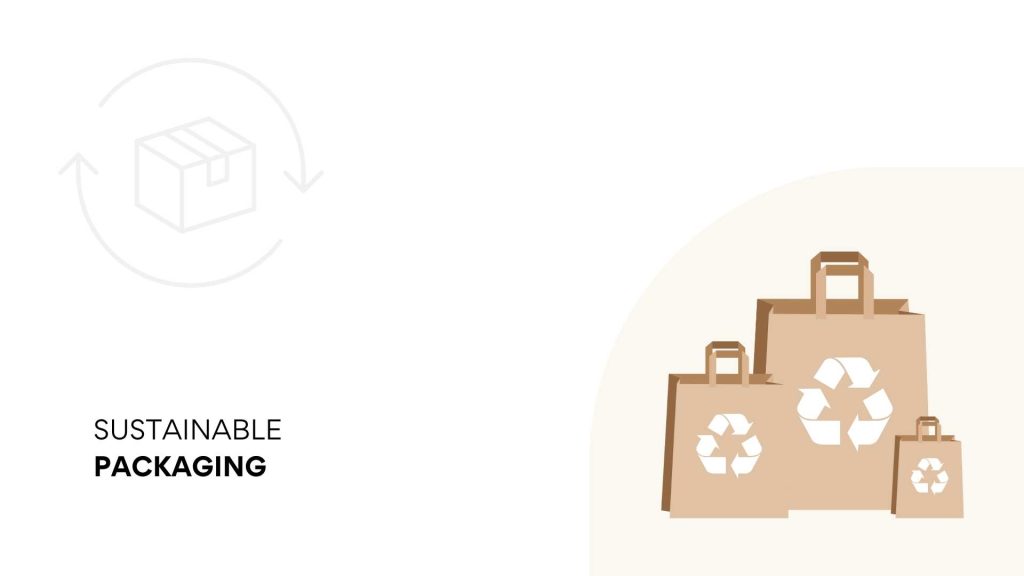The packaging industry is the beating heart of product presentation and protection, encompassing various materials, designs, and technologies. It is pivotal in preserving product integrity, enhancing consumer experiences, and facilitating global trade. Constantly evolving, this industry balances innovation with sustainability, striving to meet changing consumer demands while minimizing environmental impact. Its diverse landscape spans traditional materials like cardboard and plastics to cutting-edge advancements in biodegradable and smart packaging solutions.
What Is Sustainable Packaging?
Sustainable packaging refers to the design, creation, and use of materials for packaging goods that have minimal environmental impact throughout their lifecycle. It prioritizes eco-friendly materials, reduces waste, and aims for efficiency in production and transportation.
Sustainable packaging seeks to minimize the use of resources, such as non-renewable energy and water, while maximizing the usage of renewable or recycled materials.
It also emphasizes biodegradability, recyclability, and composability, ensuring that the packaging materials can be reused or disposed of responsibly, thereby lessening their environmental impact and contributing to a more circular economy.
How Sustainable Packaging Impacts Supply Chain
Sustainable packaging significantly influences every facet of the supply chain, revolutionizing operations from production to consumer disposal. It prompts manufacturers to source eco-friendly materials, optimize resources, and reduce waste generation during manufacturing processes.
Efficient, lighter packaging also cuts transportation costs and emissions, enhancing logistics. Additionally, it aligns with consumer preferences, fostering brand loyalty and positively impacting sales, thereby reshaping supply chain strategies towards a more environmentally conscious approach.
Challenges In Sustainable Packaging
Material Selection: Choosing sustainable packaging materials poses a challenge due to balancing durability, cost-effectiveness, and environmental impact. Finding alternatives that maintain product integrity while reducing carbon footprint remains a hurdle in the quest for sustainable packaging solutions.
Consumer Education: Educating customers about the significance of sustainable packaging and influencing their behavior towards eco-friendly choices presents a challenge. Bridging the gap between awareness and action is crucial for widespread adoption of sustainable packaging practices.
Supply Chain Complexity: Integrating sustainable packaging across intricate supply chains demands collaboration among various stakeholders. Coordinating efforts between manufacturers, distributors, and retailers to ensure consistency in eco-friendly packaging poses a considerable challenge.
Innovation and Technology: Continuous innovation in sustainable packaging technologies is essential. Overcoming the challenge of developing cutting-edge, environmentally friendly materials and methods that meet regulatory standards while being economically viable remains a constant hurdle in sustainable packaging.

Trends In Sustainable Packaging
Biodegradable Materials: Embracing biopolymers derived from renewable sources like corn starch or mushroom mycelium, These materials decompose naturally, reducing environmental impact and waste accumulation.
Minimalist Design: Streamlined packaging focuses on essentials, using less material without compromising protection employing innovative designs to reduce excess and encourage reusability.
Smart Packaging Solutions: Integrating QR codes or RFID tags enables consumers to access detailed product information, fostering transparency and aiding recycling by guiding users on proper disposal methods.
Circular Economy Models: Implementing closed-loop systems, where packaging materials are continuously recycled or repurposed, reducing reliance on new resources and minimizing the carbon footprint of packaging production.
Environment-Friendly Packaging Examples
Biodegradable Materials:
Biodegradable packaging utilizes materials that break down naturally without causing harm to the environment. For instance, packaging made from plant-based materials like cornstarch or bagasse (sugarcane waste) is compostable and can decompose, reducing landfill waste and minimizing environmental impact. These materials deliver a sustainable alternative to traditional plastics, supporting eco-friendly practices in packaging.
Recycled Content Packaging:
Packaging made from recycled materials significantly reduces the need for new resources while diverting waste from landfills. Examples include cardboard boxes from recycled paper and plastic containers produced from post-consumer recycled content. By incorporating recycled materials into packaging, companies contribute to a circular economy, promoting sustainability and reducing the environmental footprint associated with production.
Minimalist and Reusable Design:
Minimalist packaging reduces excess materials and uses reusable designs to minimize waste. Companies are embracing innovative approaches like using reusable containers or creating packaging that serves a dual purpose, such as doubling as storage or being easily repurposed for other uses. This approach reduces packaging waste and encourages consumers to adopt more sustainable practices by reusing packaging daily.
AI for packaging businesses
Revolutionize your packaging business with AI precision. Streamline operations, optimize supply chains, and enhance quality control effortlessly. Harness the power of intelligent algorithms to predict demand, reduce waste, and boost efficiency. Stay ahead in the packaging industry with cutting-edge AI solutions tailored to elevate your business performance.
Conclusion
Acumatica ERP revolutionizes the packaging industry by streamlining operations from procurement to distribution. Its robust inventory management ensures real-time tracking of packaging materials, optimizing stock levels and reducing waste. Integrated financials enable precise cost analysis and budgeting. At the same time, its adaptable workflows enhance collaboration across design, production, and shipping, empowering packaging companies to achieve efficiency and agility in a competitive market.

Vijay comes with a vast experience in ERP and enterprise solutions space with about 20 years of experience in various packaged application like Acumatica, SAP, Orion, Salesforce.com, SugarCRM and, SalesLogix.

